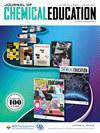Revisiting a Teaching Sequence on the Topic of Electrolysis: A Comparative Study with the Use of Artificial Intelligence
IF 2.9
3区 教育学
Q2 CHEMISTRY, MULTIDISCIPLINARY
引用次数: 0
Abstract
The literature has reported the growing use of Artificial Intelligence (AI) tools for educational purposes. This article aims to discuss the potentialities and limitations of AI in lesson planning and teacher training in chemistry and science subjects. The study compares three high school Teaching Sequences (TSs) on electrolysis, developed with and without AI’s assistance. The first, H-TS, was crafted within a Brazilian university’s Chemistry Teaching program, without AI. The other two, GPT-3.5-TS and GPT-4-TS, were independently created using GPT-3.5 and GPT-4, maintaining consistent lesson numbers and durations, and adhering to the same theoretical and methodological framework, including the use of a simulator. Findings indicate a marked improvement in TSs developed with GPT-4 over GPT-3.5. Nonetheless, both AIs exhibited limitations such as shallow reasoning and repetitive use of prompt terms, lacking in-depth didactic-pedagogical elaboration. They produced highly prescriptive sequences, potentially reinforcing misconceptions, and displayed a relative disregard for the educational context─aspects present to a lesser extent in H-TS. On a positive note, AIs demonstrated strong organizational skills, relatively adequate framework mapping, and diverse instructional and assessment strategies. The study suggests a moderate and formative use of AIs in educational contexts. It underscores the necessity for teachers to critically engage with AI-generated content and iteratively use AI to refine sequences, ensuring these do not become final products. Future research should explore AI’s practical application in TS development and its impact on preservice teacher training, aiming to critically assess and address the complexities and implications of AI-generated TSs.

重新审视以电解为主题的教学序列:使用人工智能的比较研究
文献报道,越来越多的人工智能(AI)工具被用于教育目的。本文旨在讨论人工智能在化学和科学学科的备课和教师培训中的潜力和局限性。本研究比较了三个高中电解教学序列(TS),这三个序列是在人工智能的协助下和没有人工智能的协助下开发的。第一个是 H-TS,是在巴西一所大学的化学教学计划中编制的,没有人工智能。另外两个课程,GPT-3.5-TS 和 GPT-4-TS 是使用 GPT-3.5 和 GPT-4 独立制作的,保持了一致的课程数量和持续时间,并遵循相同的理论和方法框架,包括使用模拟器。研究结果表明,与 GPT-3.5 相比,使用 GPT-4 开发的 TS 有了明显改善。然而,这两种人工智能都表现出了局限性,如推理浅薄和重复使用提示术语,缺乏深入的教学阐述。它们产生了高度指令性的序列,有可能强化了错误概念,并表现出对教育背景的相对忽视--这在 H-TS 中表现较少。从积极的方面看,人工智能教师表现出很强的组织能力、相对充分的框架映射以及多样化的教学和评估策略。这项研究表明,人工智能在教育环境中的应用是适度的、形成性的。它强调教师有必要批判性地参与人工智能生成的内容,并反复使用人工智能来完善序列,确保这些内容不会成为最终产品。未来的研究应探索人工智能在教学服务开发中的实际应用及其对职前教师培训的影响,旨在批判性地评估和解决人工智能生成的教学服务的复杂性和影响。
本文章由计算机程序翻译,如有差异,请以英文原文为准。
求助全文
约1分钟内获得全文
求助全文
来源期刊

Journal of Chemical Education
化学-化学综合
CiteScore
5.60
自引率
50.00%
发文量
465
审稿时长
6.5 months
期刊介绍:
The Journal of Chemical Education is the official journal of the Division of Chemical Education of the American Chemical Society, co-published with the American Chemical Society Publications Division. Launched in 1924, the Journal of Chemical Education is the world’s premier chemical education journal. The Journal publishes peer-reviewed articles and related information as a resource to those in the field of chemical education and to those institutions that serve them. JCE typically addresses chemical content, activities, laboratory experiments, instructional methods, and pedagogies. The Journal serves as a means of communication among people across the world who are interested in the teaching and learning of chemistry. This includes instructors of chemistry from middle school through graduate school, professional staff who support these teaching activities, as well as some scientists in commerce, industry, and government.
 求助内容:
求助内容: 应助结果提醒方式:
应助结果提醒方式:


